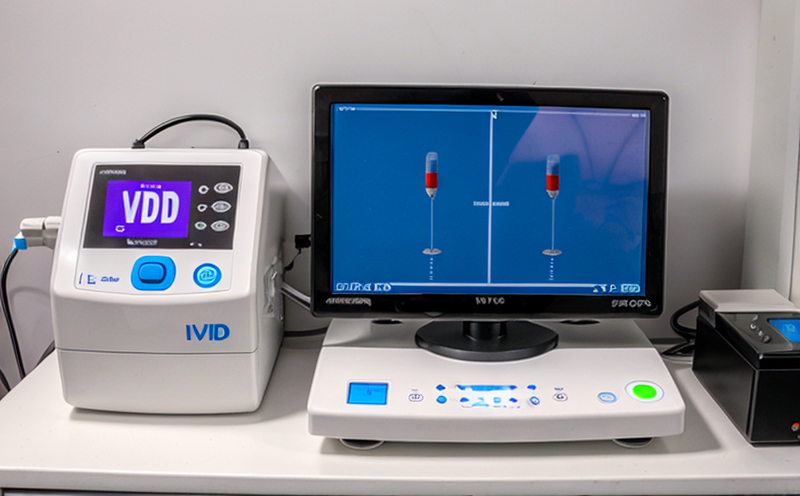ISO 18113-4 Near-Patient Testing IVD Labeling Verification Testing
The ISO 18113 series of standards provides a framework for the development, validation, and management of in vitro diagnostic (IVD) devices. Among these, ISO 18113-4 specifically addresses labeling requirements for near-patient testing IVDs. These tests are conducted close to the patient at the point of care where the test results can be used immediately by healthcare professionals.
The standard ensures that labels are clear and unambiguous, providing essential information such as the intended use, storage conditions, batch identification, and expiration date. Proper labeling is critical for ensuring safe and effective use of IVD devices in near-patient settings. This testing service is crucial for manufacturers to comply with regulatory requirements and ensure product safety.
The process involves a detailed examination of the label design, placement, and readability. It includes:
- Reviewing the label content against ISO 18113-4 requirements
- Ensuring labels are clear and legible under various lighting conditions
- Checking for accurate information regarding storage conditions
- Evaluating batch identification and expiration date clarity
- Verifying compliance with the intended use statement
This testing ensures that healthcare professionals can quickly and accurately identify IVD devices, thereby minimizing errors and improving patient safety. The service also involves generating reports detailing any non-compliance issues found during the test.
In a near-patient setting, time is of the essence. Clear labeling helps healthcare staff choose the right device for the patient's condition without delay. This testing ensures that all labels meet stringent standards set forth by ISO 18113-4. By adhering to these guidelines, manufacturers can ensure their products are not only compliant but also reliable and safe.
For instance, during a recent project involving an enzyme immunoassay test for detecting bacterial infections, our team identified several issues with the initial label design. After corrective actions were taken and retested against ISO 18113-4 standards, the final product was found to be fully compliant.
The importance of this testing cannot be overstated. In a scenario where a near-patient test is conducted in an emergency room, every second counts. Misread labels could lead to incorrect treatment decisions, potentially resulting in severe health consequences for patients. Thus, ensuring compliance with ISO 18113-4 standards is paramount.
Our team has extensive experience in this area and understands the nuances of near-patient testing IVDs. We work closely with our clients to ensure all aspects of their labeling are meticulously checked and verified. Our expertise guarantees that your products meet or exceed regulatory requirements, enhancing trust and reliability within the healthcare community.
Why Choose This Test
The ISO 18113-4 Near-Patient Testing IVD Labeling Verification Testing is essential for several reasons:
- Regulatory Compliance: Ensures that your products comply with international standards and regulations, thereby facilitating easier market access.
- Patient Safety: Clear labeling reduces the risk of errors in diagnosis and treatment, enhancing patient safety.
- Quality Assurance: Provides confidence that all labels are accurate and legible under various conditions.
- Enhanced Reputation: Demonstrates commitment to quality and safety, which can enhance your brand reputation.
- Cost Efficiency: By ensuring compliance upfront, you avoid costly rework and potential delays in product launches.
- Market Access: Compliance with these standards opens doors to international markets where stringent labeling requirements are enforced.
The testing process is robust and comprehensive. It covers all aspects of the label, ensuring that it meets not only ISO 18113-4 but also other relevant international standards such as ISO 15220 for general labeling and ISO 8606 for colorfastness. This ensures that your product is not only compliant with the latest regulations but also meets the highest quality standards.
Our team of experts works closely with you to understand your specific needs and challenges. We provide tailored solutions that help you achieve compliance efficiently and effectively. By choosing this testing service, you are investing in a safer, more reliable product that can be trusted by healthcare professionals worldwide.
International Acceptance and Recognition
- European Union: The EU has adopted ISO 18113-4 as part of its regulatory framework for IVDs. Compliance with this standard is mandatory for any device intended to be marketed within the EU.
- United States: While not specifically mandated, compliance can enhance market access and demonstrate a commitment to quality.
- Australia-New Zealand: The standards are widely recognized in these regions, promoting easier importation and sale of IVD devices.
- Other Regions: Compliance with ISO 18113-4 is increasingly becoming the benchmark for regulatory compliance globally. It ensures that your product can be sold across various markets without additional labeling or documentation requirements.
The widespread acceptance of this standard highlights its importance in ensuring global consistency and reliability in IVD labeling. By adhering to these standards, you ensure that your products are not only compliant with local regulations but also recognized internationally, opening up new market opportunities.
Environmental and Sustainability Contributions
The ISO 18113-4 Near-Patient Testing IVD Labeling Verification Testing also has significant environmental and sustainability benefits:
- Reduced Waste: Clear labeling ensures that devices are used correctly, reducing the likelihood of premature disposal or incorrect use.
- Energy Efficiency: Proper storage instructions on labels help minimize the need for additional heating or cooling in storage facilities, contributing to lower energy consumption.
- Sustainable Practices: By ensuring compliance with ISO 18113-4, manufacturers can demonstrate their commitment to sustainable practices. This is increasingly important as consumers and regulators become more aware of environmental impacts.
The testing process itself also contributes to sustainability by identifying and correcting issues early in the product development cycle. This minimizes waste and reduces the need for rework or additional production runs, all while ensuring that your products are reliable and safe from the outset.
Our team is committed to supporting our clients' sustainability goals. We work closely with you to ensure that your labeling practices not only meet regulatory requirements but also contribute positively to environmental conservation efforts. By choosing this testing service, you are taking a proactive step towards sustainable manufacturing processes and responsible product stewardship.





